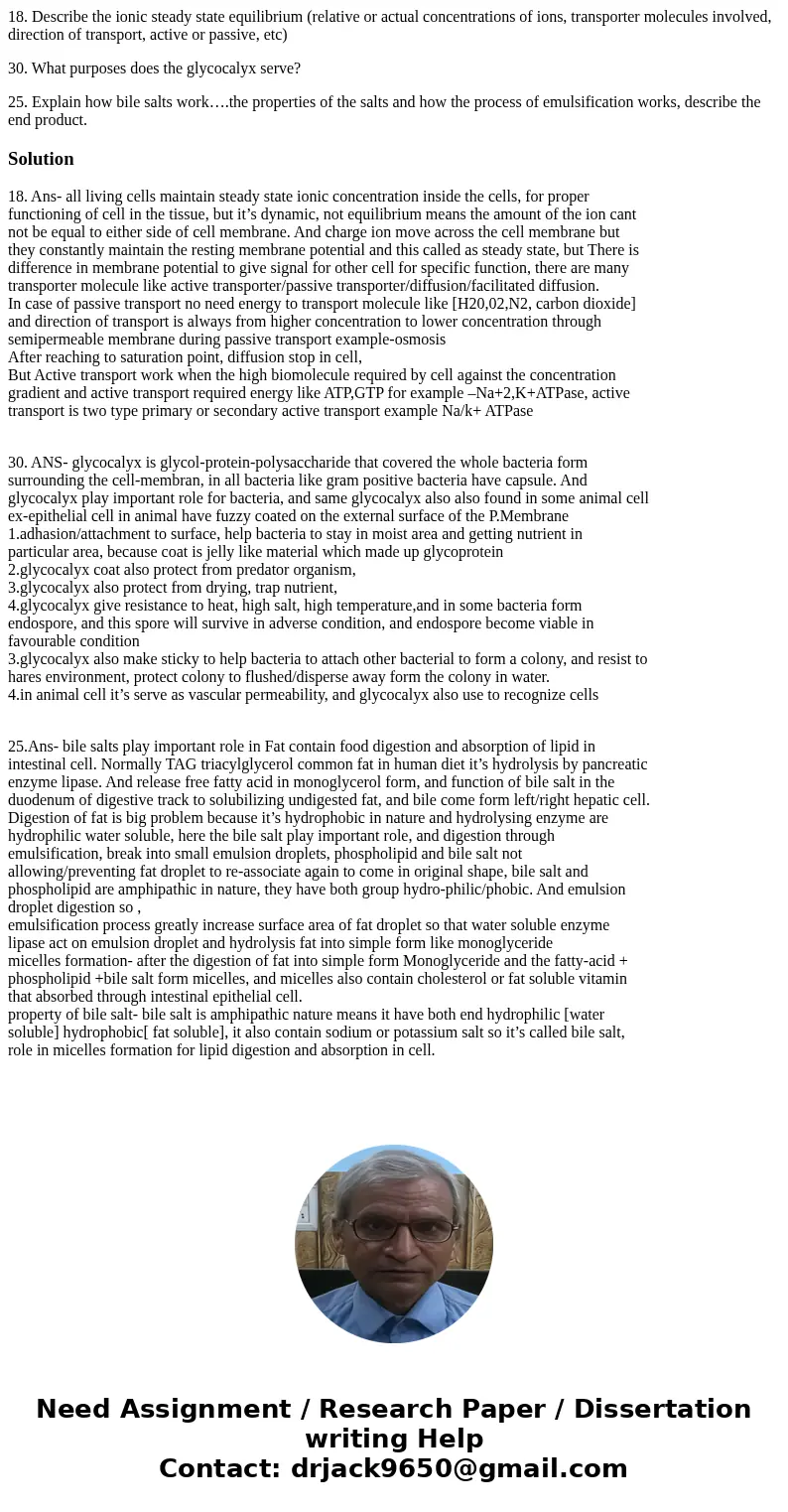18 Describe the ionic steady state equilibrium relative or a
18. Describe the ionic steady state equilibrium (relative or actual concentrations of ions, transporter molecules involved, direction of transport, active or passive, etc)
30. What purposes does the glycocalyx serve?
25. Explain how bile salts work….the properties of the salts and how the process of emulsification works, describe the end product.
Solution
18. Ans- all living cells maintain steady state ionic concentration inside the cells, for proper
functioning of cell in the tissue, but it’s dynamic, not equilibrium means the amount of the ion cant
not be equal to either side of cell membrane. And charge ion move across the cell membrane but
they constantly maintain the resting membrane potential and this called as steady state, but There is
difference in membrane potential to give signal for other cell for specific function, there are many
transporter molecule like active transporter/passive transporter/diffusion/facilitated diffusion.
In case of passive transport no need energy to transport molecule like [H20,02,N2, carbon dioxide]
and direction of transport is always from higher concentration to lower concentration through
semipermeable membrane during passive transport example-osmosis
After reaching to saturation point, diffusion stop in cell,
But Active transport work when the high biomolecule required by cell against the concentration
gradient and active transport required energy like ATP,GTP for example –Na+2,K+ATPase, active
transport is two type primary or secondary active transport example Na/k+ ATPase
30. ANS- glycocalyx is glycol-protein-polysaccharide that covered the whole bacteria form
surrounding the cell-membran, in all bacteria like gram positive bacteria have capsule. And
glycocalyx play important role for bacteria, and same glycocalyx also also found in some animal cell
ex-epithelial cell in animal have fuzzy coated on the external surface of the P.Membrane
1.adhasion/attachment to surface, help bacteria to stay in moist area and getting nutrient in
particular area, because coat is jelly like material which made up glycoprotein
2.glycocalyx coat also protect from predator organism,
3.glycocalyx also protect from drying, trap nutrient,
4.glycocalyx give resistance to heat, high salt, high temperature,and in some bacteria form
endospore, and this spore will survive in adverse condition, and endospore become viable in
favourable condition
3.glycocalyx also make sticky to help bacteria to attach other bacterial to form a colony, and resist to
hares environment, protect colony to flushed/disperse away form the colony in water.
4.in animal cell it’s serve as vascular permeability, and glycocalyx also use to recognize cells
25.Ans- bile salts play important role in Fat contain food digestion and absorption of lipid in
intestinal cell. Normally TAG triacylglycerol common fat in human diet it’s hydrolysis by pancreatic
enzyme lipase. And release free fatty acid in monoglycerol form, and function of bile salt in the
duodenum of digestive track to solubilizing undigested fat, and bile come form left/right hepatic cell.
Digestion of fat is big problem because it’s hydrophobic in nature and hydrolysing enzyme are
hydrophilic water soluble, here the bile salt play important role, and digestion through
emulsification, break into small emulsion droplets, phospholipid and bile salt not
allowing/preventing fat droplet to re-associate again to come in original shape, bile salt and
phospholipid are amphipathic in nature, they have both group hydro-philic/phobic. And emulsion
droplet digestion so ,
emulsification process greatly increase surface area of fat droplet so that water soluble enzyme
lipase act on emulsion droplet and hydrolysis fat into simple form like monoglyceride
micelles formation- after the digestion of fat into simple form Monoglyceride and the fatty-acid +
phospholipid +bile salt form micelles, and micelles also contain cholesterol or fat soluble vitamin
that absorbed through intestinal epithelial cell.
property of bile salt- bile salt is amphipathic nature means it have both end hydrophilic [water
soluble] hydrophobic[ fat soluble], it also contain sodium or potassium salt so it’s called bile salt,
role in micelles formation for lipid digestion and absorption in cell.

 Homework Sourse
Homework Sourse